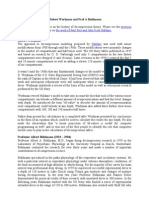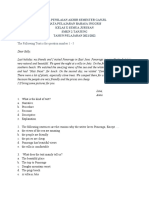Some Objects
Some Objects
Uploaded by
Erline Bismonte AndayaCopyright:
Available Formats
Some Objects
Some Objects
Uploaded by
Erline Bismonte AndayaCopyright
Available Formats
Share this document
Did you find this document useful?
Is this content inappropriate?
Copyright:
Available Formats
Some Objects
Some Objects
Uploaded by
Erline Bismonte AndayaCopyright:
Available Formats
Some objects, when placed in water, float, while others sink, and still others neither float nor
sink. This is a function of buoyancy. We call objects that float, positively buoyant. Objects that sink are called negatively buoyant. We refer to object that neither float nor sink as neutrally buoyant. The idea of buoyancy was summed up by Archimedes, a Greek mathematician, in what is known as Archimedes Principle: Any object, wholly or partly immersed in a fluid, is buoyed up by a force equal to the weight of the fluid displaced by the object. Archimedes principle works for any fluid, but to divers, they are mainly concerned with two different fluids: fresh water, and salt water. We need to think of fresh water and salt water as two different fluids because equal volumes of fresh water and salt water do not weigh the same. For example, a cubic foot of fresh water weighs approximately 62.4 lbs, while a cubic foot of salt water weighs approximately 64 lbs. The extra weight is because of the dissolved minerals in salt water. Lets witness an application of the archimedes principle ------------cut----------The materials we need are 3 cups, 3 eggs and salt. Fill the 3 glasses with equal amount of water and place a fresh egg in one of the glasses, lets observe what happen. We can see that the egg sinks. On the second cup, put 4 teaspoons of water and stir it up. Place another egg and observe what happen. As you can see, the egg floats. On the final glass, put 4 tsp of salt and stir it up and pour out some of the salt water. Now place an egg in the water. Slowly and carefully pour fresh water into the glass of salt water and watch as the egg sinks down till the middle. How can we explain these? The egg sank on the first cup because it doesnt displace enough water making the egg more dense than the water around it. It created an unbalanced force which sends the egg to the bottom of its container. This force is called the buoyant force. The egg is negatively buoyant. The egg floated on the second cup because when we add salt to water and stir, the salt crystals break down into molecules and fill in the holes inbetween the water molecules. The solution now has more mass in the same space or volume, which changes the density of the water. When we add the egg to the salt water, it displaced the same amount of water but that space has more molecules in it thats why the egg becomes less dense then the salt water around it. The egg is positively buoyant. On the third cup, the egg stayed in the middle because when we slowly add fresh water to salt water, the less dense fresh water floats on top of the more dense salt water that created a density column of water. The egg sank through the less dense fresh water and floated on the more dence salt water. The egg is neutrally buoyant. -----------cut------------To summarize all these, Archimedes principle relates buoyancy to displacement. Any floating object displaces its own weight of fluid.
You might also like
- Dive Theory Study GuideDocument40 pagesDive Theory Study GuideAlex D.85% (13)
- Touchstone 3Document17 pagesTouchstone 3GrissGS100% (3)
- AIDA2 ManualDocument110 pagesAIDA2 ManualBorislava Marjanovic100% (3)
- Lab1 Floating EggsDocument8 pagesLab1 Floating Eggsneetijain110% (1)
- Floating Egg in WaterDocument2 pagesFloating Egg in WaterMary Ann PerezNo ratings yet
- Monument Above Ground Pool Installation GuideDocument12 pagesMonument Above Ground Pool Installation GuideDarrenNo ratings yet
- 9 Archimedes PrincipleDocument18 pages9 Archimedes PrincipleAkhilesh ChauhanNo ratings yet
- Section 2 - Buoyancy and DensityDocument12 pagesSection 2 - Buoyancy and DensityAbdur RoufNo ratings yet
- Water Density - EggDocument5 pagesWater Density - EggMagi ThiranNo ratings yet
- Archimedes ExperienceDocument5 pagesArchimedes Experienceالغزيزال الحسن EL GHZIZAL HassaneNo ratings yet
- What Eggsactly Is Going On HereDocument2 pagesWhat Eggsactly Is Going On Here4fssgxnnkxNo ratings yet
- Science Fair PrintDocument12 pagesScience Fair PrintTrung Ngô Lê BảoNo ratings yet
- ArchimedesDocument6 pagesArchimedesAnnie AlbertoNo ratings yet
- Gravity, Buoyancy, and The Stability of A Floating Object PDFDocument5 pagesGravity, Buoyancy, and The Stability of A Floating Object PDFNur Amira Mardiana ZulkifliNo ratings yet
- Chapter-1 - MATTER IN OUR SURROUNDINGSDocument20 pagesChapter-1 - MATTER IN OUR SURROUNDINGSSATYAM RATHOURNo ratings yet
- Anaphy DRAFT Experiment 1 CHQDocument5 pagesAnaphy DRAFT Experiment 1 CHQShiela ClementeNo ratings yet
- Physics Project Class 11Document5 pagesPhysics Project Class 11Dr. Jyotsna GuptaNo ratings yet
- LS The Magic EggsDocument2 pagesLS The Magic EggsLucky BeeNo ratings yet
- James' Watts Group.Document19 pagesJames' Watts Group.lim chuan yangNo ratings yet
- The Lava LampDocument5 pagesThe Lava LampMathew DegamoNo ratings yet
- Project Report Physics 1Document13 pagesProject Report Physics 1anmolmkulkarniNo ratings yet
- WATERDocument7 pagesWATERnelliempofu2No ratings yet
- Kerala Syllabus 9th Standard Physics Solutions Chapter 1 Forces in FluidsDocument21 pagesKerala Syllabus 9th Standard Physics Solutions Chapter 1 Forces in Fluidssajith kumar VariathNo ratings yet
- Lava LampDocument2 pagesLava LampRoland Garcia Pelagio Jr.No ratings yet
- Laboratory Activity 2: OsmosisDocument4 pagesLaboratory Activity 2: OsmosisBerfelyn Daniela VillaruzNo ratings yet
- Environmental Engineering Project: OsmosisDocument18 pagesEnvironmental Engineering Project: OsmosisKeerthiNo ratings yet
- Properties of Water Station LabDocument6 pagesProperties of Water Station Lablaquisha.smithNo ratings yet
- Matter in Our Surroundings Notes: Matter Is Made of ParticlesDocument7 pagesMatter in Our Surroundings Notes: Matter Is Made of ParticlesVedha SinghNo ratings yet
- Displacement Physics P and DDocument1 pageDisplacement Physics P and DNyomie CoxNo ratings yet
- Why Things Float - Class 8Document6 pagesWhy Things Float - Class 8Mounika UradiNo ratings yet
- Diffusion EssayDocument2 pagesDiffusion Essayapi-242424506No ratings yet
- Verification of Archimedes PrincipalDocument11 pagesVerification of Archimedes PrincipaldemonkingsunnykumarNo ratings yet
- Catch A RainbowDocument6 pagesCatch A Rainbowbech1No ratings yet
- General Physics2 ScriptDocument2 pagesGeneral Physics2 ScriptClaire DonilaNo ratings yet
- Salt Water Egg ExperimentDocument2 pagesSalt Water Egg ExperimentSANTHIYA A/P KALITHASAN MoeNo ratings yet
- Properties of Water Reading - (1 - )Document4 pagesProperties of Water Reading - (1 - )amlamb553No ratings yet
- Water ChemistryDocument6 pagesWater Chemistryyoshi0046No ratings yet
- Physics Project Tentative HahaDocument15 pagesPhysics Project Tentative Hahaincognitosalve2006No ratings yet
- Sample PHYSICSINVESTIGATORYDocument13 pagesSample PHYSICSINVESTIGATORYrishi.amaravathi123No ratings yet
- Archimedes' Principle of FlotationDocument4 pagesArchimedes' Principle of FlotationANam MUkri92% (24)
- Cycle 3 - Tutor Science Book Continued - Weeks 13-18Document16 pagesCycle 3 - Tutor Science Book Continued - Weeks 13-18fanytantavilcaNo ratings yet
- Modeling OsmosisDocument3 pagesModeling Osmosisapi-193601935No ratings yet
- Physics-Project: Name-Ayush Singh Class-9H Subject Teacher - Mr. Amardepp Tripathi Class Teacher-Ms Pankhuri SinghDocument11 pagesPhysics-Project: Name-Ayush Singh Class-9H Subject Teacher - Mr. Amardepp Tripathi Class Teacher-Ms Pankhuri SinghAyush SinghNo ratings yet
- 13 Liquids Questions & AnswersDocument22 pages13 Liquids Questions & AnswersSheenly Joy AbalajenNo ratings yet
- Mapp 3Document2 pagesMapp 3api-279900003No ratings yet
- Forces and Fluids ProjectDocument7 pagesForces and Fluids ProjectJose MederoNo ratings yet
- Archemids PrincipleDocument10 pagesArchemids PrincipleMUHAMMAD AKRAMNo ratings yet
- Buoyancy ExperimentDocument11 pagesBuoyancy ExperimentAdinda SitiNo ratings yet
- Exp206 Des Principle-1Document7 pagesExp206 Des Principle-1Tiea Maryze VillanuevaNo ratings yet
- Properties of Water Station LabDocument8 pagesProperties of Water Station LabZakaria HashiNo ratings yet
- Step 1: What Do We Know?: Salt Water ExperimentDocument3 pagesStep 1: What Do We Know?: Salt Water ExperimentAmani MorriesonNo ratings yet
- Properties of Water and Intermolecular ForcesDocument34 pagesProperties of Water and Intermolecular Forcesjoshua gollosoNo ratings yet
- Physics Investigatory Project 2023-2024Document11 pagesPhysics Investigatory Project 2023-2024Saanavi KolatNo ratings yet
- Osmosis LabDocument3 pagesOsmosis Labapi-333810716No ratings yet
- Jon Emmanuel G. Velasco 3RD - Quarter - Peta Homelab Lab WorksheetDocument18 pagesJon Emmanuel G. Velasco 3RD - Quarter - Peta Homelab Lab WorksheetdjisthecoolNo ratings yet
- Physical Properties of Water: Richie Juls Bacalso Ma. Annalyn Mulig Wendell JualoDocument15 pagesPhysical Properties of Water: Richie Juls Bacalso Ma. Annalyn Mulig Wendell JualoRichie Juls BacalsoNo ratings yet
- Sheniblog IX - Phy.unit.1 (EM)Document7 pagesSheniblog IX - Phy.unit.1 (EM)Rema DeviNo ratings yet
- 5 Grade - Lesson 1.3 Dissolving and Back Again: ObjectiveDocument4 pages5 Grade - Lesson 1.3 Dissolving and Back Again: ObjectiveManushka ThomasNo ratings yet
- 5 Grade - Lesson 1.3 Dissolving and Back Again: ObjectiveDocument4 pages5 Grade - Lesson 1.3 Dissolving and Back Again: ObjectiveManushka ThomasNo ratings yet
- FluidsDocument55 pagesFluidsdanena88No ratings yet
- 2.2 Presentation WaterDocument98 pages2.2 Presentation WaterSurya KarthikeyanNo ratings yet
- Matter in Our Surroundings - NotesDocument16 pagesMatter in Our Surroundings - Noteseeren41789No ratings yet
- Do Fish Drink WaterDocument3 pagesDo Fish Drink WaterAbdellah KaddouriNo ratings yet
- Pure Water: The Science of Water, Waves, Water Pollution, Water Treatment, Water Therapy and Water EcologyFrom EverandPure Water: The Science of Water, Waves, Water Pollution, Water Treatment, Water Therapy and Water EcologyNo ratings yet
- Deep Water Short Answer Type QuestionsDocument3 pagesDeep Water Short Answer Type QuestionsRav NeetNo ratings yet
- Diving O&g411Document52 pagesDiving O&g411phsemNo ratings yet
- Decompression Theory - Robert Workman and Prof A BuhlmannDocument2 pagesDecompression Theory - Robert Workman and Prof A Buhlmanna100% (1)
- International Youth Diving Meet Dresden 2012Document160 pagesInternational Youth Diving Meet Dresden 2012Tomislav BorićNo ratings yet
- Unit3 Sports WorksheetDocument4 pagesUnit3 Sports WorksheetNafirKeyhNo ratings yet
- Design Project Phase 3 Final ReportDocument10 pagesDesign Project Phase 3 Final Reportapi-233198198No ratings yet
- Bahasa Inggris: This Text Is For Question No 1 - 5Document15 pagesBahasa Inggris: This Text Is For Question No 1 - 5Bowosang SangNo ratings yet
- HE2 CH 31Document40 pagesHE2 CH 31AliNo ratings yet
- Pe and Health 4 - Week 1 To 4Document19 pagesPe and Health 4 - Week 1 To 4MikeeeeNo ratings yet
- ĐỀ THAM KHẢO ÔN TUYỂN SINH VÀO 10 CÓ KEYDocument4 pagesĐỀ THAM KHẢO ÔN TUYỂN SINH VÀO 10 CÓ KEYgukjevalieNo ratings yet
- SOLAS REQUIREMENT's FOR LIFEJACKETDocument3 pagesSOLAS REQUIREMENT's FOR LIFEJACKETGiorgi Kandelaki100% (1)
- Ann Cristy EnthralledDocument71 pagesAnn Cristy EnthralledVijayalaxmi N. VarnekarNo ratings yet
- Pressure in LiquidsDocument2 pagesPressure in LiquidsFaran AzeemNo ratings yet
- English Chapter 3 PresentationDocument8 pagesEnglish Chapter 3 PresentationStephen GheevargheseNo ratings yet
- SRDocument3 pagesSRRainnier LauguicoNo ratings yet
- Group 1: Bautista, Marianne Gonzales, Jielene Patacsil, JerelynDocument19 pagesGroup 1: Bautista, Marianne Gonzales, Jielene Patacsil, Jerelynvince gonzalesNo ratings yet
- BID QoutationDocument6 pagesBID QoutationELLAINE OCLARITNo ratings yet
- 147 Profitable Niches Merch Campus Exclusive.01 PDFDocument6 pages147 Profitable Niches Merch Campus Exclusive.01 PDFSahil Shah100% (2)
- 5 Absolutely Beautiful Places in LeyteDocument1 page5 Absolutely Beautiful Places in LeyteBigg ClicksNo ratings yet
- s1 Return To Air NotesDocument2 pagess1 Return To Air Notesumjadon2No ratings yet
- Soal Penilaian Akhir Semester Bahasa Inggris Ganjil Kelas X Semua JurusanDocument8 pagesSoal Penilaian Akhir Semester Bahasa Inggris Ganjil Kelas X Semua JurusanAnitaRNo ratings yet
- SUUNTO Solution - Alpha - Manual - ENDocument41 pagesSUUNTO Solution - Alpha - Manual - ENEUROTANK MARITIMENo ratings yet
- Special Forces Military Free-Fall OperationsDocument295 pagesSpecial Forces Military Free-Fall Operationsncore_scribd100% (3)
- Navy Diving ManualDocument992 pagesNavy Diving ManualDaniela M Gutiérrez Sierra100% (1)
- 70PCVBA Air BoosterDocument20 pages70PCVBA Air BoosterWirote DewilaiNo ratings yet
























































































